RTHD-SVX01D-EN 133
Maintenance Procedures
Cleaning the Condenser
CAUTION
Proper Water Treatment!
The use of untreated or improperly treated water in a RTHD may
result in scaling, erosion, corrosion, algae or slime. It is
recommended that the services of a qualified water treatment
specialist be engaged to determine what water treatment, if any,
is required. The Trane Company assumes no responsibility for
equipment failures which result from untreated or improperly
treated water, saline or brackish water.
Condenser tube fouling is suspect when the “approach” temperature (i.e.,
the difference between the refrigerant condensing temperature and the leav-
ing condenser water temperature) is higher than predicted.
Standard water applications will operate with less than a 10
o
F approach. If the
approach exceeds 10
o
F cleaning the condenser tubes is recommended.
NOTE: Glycol in the water system typically doubles the standard approach.
If the annual condenser tube inspection indicates that the tubes are fouled, 2
cleaning methods can be used to rid the tubes of contaminants.The methods
are:
Mechanical Cleaning Procedure
Mechanical tube cleaning this method is used to remove sludge and loose
material from smooth-bore condenser tubes.
WARNING
Heavy Objects!
Each of the individual cables (chains or slings) used to lift the
waterbox must be capable of supporting the entire weight of the
waterbox. The cables (chains or slings) must be rated for
overhead lifting applications with an acceptable working load
limit. Failure to properly lift waterbox could result in death or
serious injury.
Eyebolts!
The proper use and ratings for eyebolts can be found in ANSI/
ASME standard B18.15. Maximum load rating for eyebolts are
based on a straight vertical lift in a gradually increasing manner.
Angular lifts will significantly lower maximum loads and should
be avoided whenever possible. Loads should always be applied to
eyebolts in the plane of the eye, not at some angle to this plane.
Failure to properly lift waterbox could result in death or serious
injury.

